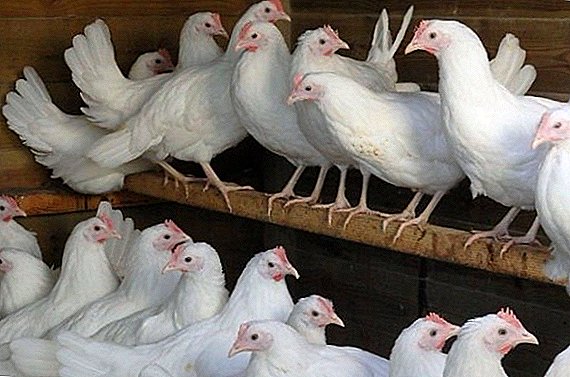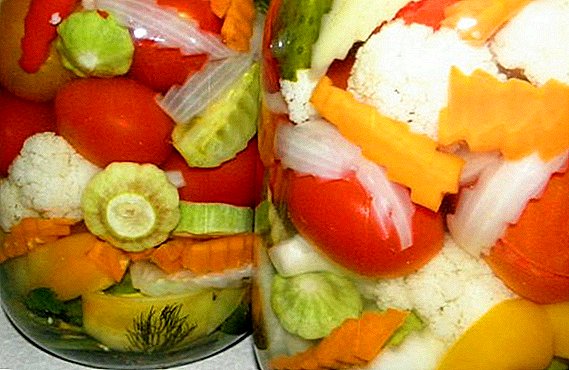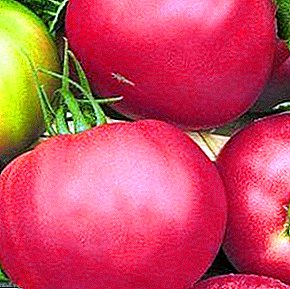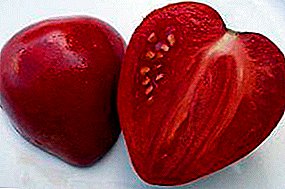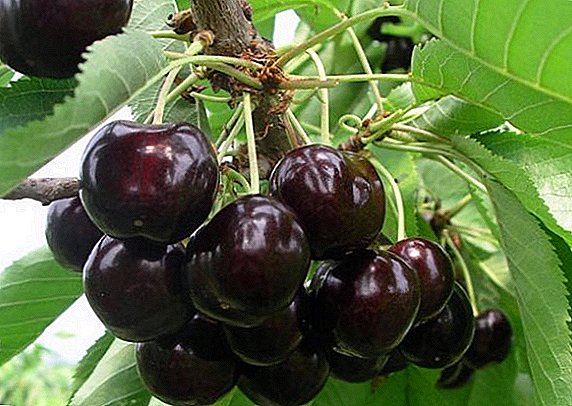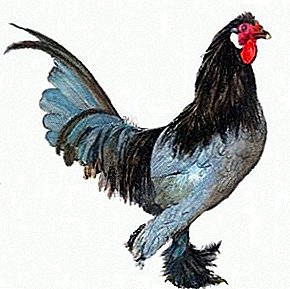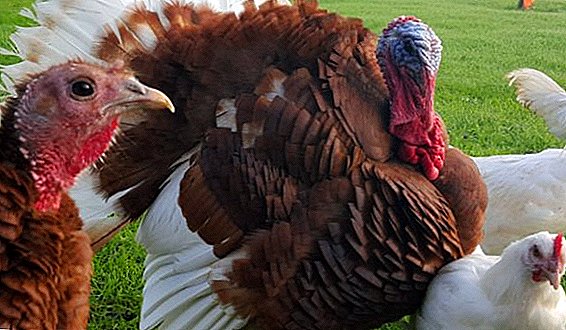 When breeding poultry, farmers often need to combine several species of birds in one poultry house, we will talk about how to do this correctly, the advantages and disadvantages of such cohabitation, the characteristics of housing and feeding in this article.
When breeding poultry, farmers often need to combine several species of birds in one poultry house, we will talk about how to do this correctly, the advantages and disadvantages of such cohabitation, the characteristics of housing and feeding in this article.
Is it possible to keep chickens and turkeys together
Chickens and turkeys are very similar in appearance, so many people think that living together in the house is the norm. However, each species of domestic birds requires special conditions of detention and feeding, which also needs to be taken into account.

What is the advantage
- Saving cash. A common poultry house eliminates the need to build a separate building to house each species of domestic birds, creating a walking yard. However, saving on the creation of feeders and drinking bowls is not worth it, it can significantly affect the health and microclimate in the bird house.
- Save time. Cleaning in the house, which involves the creation and maintenance of cleanliness, timely replacement of bedding, climate control, the supply of fresh food and water - all this takes a lot of time and effort.
- The possibility of compact placement in a small area. In conditions when the poultry farmer has a small plot of land, the creation of a compact but functional joint house can be a great solution.
Did you know? Chickens love to take a bath of ash and sand. To do this, put a box in the hen house with a dry mixture of these bulk substances. Bathing in them, the birds themselves are cleaned of parasites.
disadvantages
- The complexity of the character. The individual characteristics of birds can be pronounced, and this in turn can lead to problems of coexistence of several species of birds in the same area. For example, turkeys are very capricious, while chickens may show aggression towards neighbors with a “temper”.
- Carriers of dangerous diseases. Turkey feces often contain pathogens of a terrible disease - infectious typhoid, which is able to spread rapidly. As a rule, it leads to epidemics and a significant bird mora. In addition, chickens can infect turkeys with heterotex worms, which are not dangerous for the former, and destructive for the latter.
- Different nutritional needs. Turkeys and turkeys are superior in their mass of chickens and roosters, which means they require more feed and are not averse to feast on an additional portion of nutrients, while chickens may not get any food from the common trough.
- Different motor needs. Chickens are very energetic and spend most of their time in motion, while turkeys prefer a quieter rhythm of life and may suffer from lively neighbors.
- Nutrition features. The need to get vitamin B in turkeys is several times higher than in chickens. Its deficiency threatens the occurrence of pyelonephritis, and therefore their nutrition must contain yeast and vegetable fibers.

The joint content of chickens and turkeys
The stay of several species of birds in a single closed territory invariably leads to the emergence of various kinds problems that are largely dependent on factors such as:
- breed of bird;
- the number of birds;
- conditions of detention;
- quality of care.
Important! Turkeys are very susceptible to various diseases, because their alkaline level is higher than that of chickens and other agricultural birds, and, therefore, bacteria multiply in their bodies faster. When kept together with other species of birds, they can infect and expose them to increased danger.
The necessary conditions
Experts recommend adhering to the following rules of joint stay of chickens and turkeys:
- The joint keeping of birds in a single area is best to start from an early age.. Chicks and turkeys should be placed in the house at the same time. In this case, they will quickly get used to each other, and interspecific conflicts will not occur. If adult birds are moved to a live-in chicken house, fights are possible, and since chickens and turkeys are in unequal weight categories, such conflicts may result in the death of individuals.
- Enough free space for each bird will help reduce the risk of collisions between birds. When building a chicken coop, its size should be calculated based on the norm 0.5 m² per chicken and 0.8 m² per turkey. You should also pay close attention to the size of the walking yard. Since each bird should be able not only to move freely, but also to make “jogs,” its dimensions should be large enough. Physical activity of poultry is the key to their health and good egg production. If necessary, the walking yard can be covered with a net or an awning, or you can trim the wings of a bird in order to prevent the bird from flying over the fence of the courtyard. Poultry houses often divide the walking area for each species of bird, which contributes to the normal coexistence of different breeds.
- Observance of cleanliness. Because turkeys are more susceptible to bacteria spreading in the dirt and litter in the hen house, cleanliness in the house should be kept under constant review. Farmers should clean up more often in order to avoid outbreaks of various diseases.
- During the joint keeping of different types of poultry, and in winter, possibly other livestock, should be kept under control. air humidity. Large livestock leads to an increase in the humidity level, which means that it needs good air exchange.
- Prevention of parasites and diseases. The density of livestock in a single room can contribute to the spread of fleas, ticks, lousefishes, as well as various diseases. Regular bedding changes, cleanliness, anthelmintic treatment in the house are an important preventive measure.


Find out if you can keep together chickens of different ages, chickens with rabbits, ducks, quails.
Feeding features
Despite the external similarity of chickens and turkeys, their diet is somewhat different. When creating joint conditions for the stay of these two types of poultry, it should be possible to separate them by organizing separate feeders and drinkers.  Feeding poultry should be carried out, taking into account the biological characteristics of the species, breed, level of productivity, age, sex, conditions of detention.
Feeding poultry should be carried out, taking into account the biological characteristics of the species, breed, level of productivity, age, sex, conditions of detention.
Read also about the manufacture of feeders and drinkers for chickens, drinkers for turkeys.
Chickens
The egg breeds of chickens that are kept in the household are fed in the process of growing, three times changing the diet for young stock from 1 to 7 weeks, and then from 8-16 and 17-20 weeks. Adult birds change their diet twice, at the age of 21-45 weeks.  The calculation of the volume and composition of the diet is calculated on the basis of the norms of exchange energy, crude protein, amino acids and mineral substances in compound feeds.
The calculation of the volume and composition of the diet is calculated on the basis of the norms of exchange energy, crude protein, amino acids and mineral substances in compound feeds.
Find out how much to feed the laying hen for a day.
Laying hens should be eaten:
- Combined feed. Feed the complete mixture of layers should be no more than twice a day. The amount of feed in the feeder should not exceed 2/3. If you exceed this rate, then all the surplus will be simply scattered, so the feed consumption will increase by 20-40%. Per day one layer eats 120 g of dry food.
- Wet mash. The amount of such food should be such that the bird can eat it in 30-40 minutes, since the continued presence of such food in the feeder can lead to souring and the spread of adverse bacteria. It is worth noting the importance of keeping the feeder clean, the regularity of harvesting and the timely removal of the uneaten food. You can repeat feeding sessions 3-4 times a day. In winter, wet mash is prepared on the basis of fish or meat broth, and whey, buttermilk, and reverse can also be used as a base.
- Corn. It is mostly night food.
- Succulent and green food. Beneficial effect on the health of the bird, productivity and vitality.
The productivity phase of the laying hen is also a key element in the preparation of the poultry diet.  The first phase begins at the time of the first egg-laying and up to the age of 48 weeks. This period is characterized by an increase in the intensity of egg production and an increase in the weight of laying eggs, while the process of chicken growth continues.
The first phase begins at the time of the first egg-laying and up to the age of 48 weeks. This period is characterized by an increase in the intensity of egg production and an increase in the weight of laying eggs, while the process of chicken growth continues.
Therefore, the diet should contain a maximum of energy and nutrients per day:
- corn - 40 g;
- wheat - 20 g;
- potatoes (boiled) - 50 g;
- carrots (boiled) - 10 g;
- fish meal - 4 g;
- bone meal - 1 g;
- meat and fish waste - 5 g;
- chalk - 3 g;
- cockleshell - 5 g;
- greens - 30 g
Learn more about the nutrition of chickens: how to give premixes, peas, oats, salt, garlic, meat and bone meal, wheat germ, bran, bread, worms, fish oil to chickens; what to feed chickens; mineral supplements for chickens.
The second phase is from the 48th week to the end of the layer. The bird carries fewer eggs and no longer grows, which means it requires less feeding:
- wheat - 40 g;
- barley - 30 g;
- potatoes (boiled) - 50 g;
- pumpkin (boiled) - 20 g;
- yeast - 14 g;
- bone meal - 1 g;
- meat and fish waste - 10 g;
- chalk - 3 g;
- cockleshell - 5 g;
- greens - 30 g

Turkeys
The main source of nutrition for turkeys is feedhowever, during walks in the walking yard, they can diversify their diet by eating: a beetle, a caterpillar, a mouse, a frog, a worm, an insect pupa, a larva. The turkey can eat the Colorado potato beetle, beetroot carnivore, slugs. These birds can also eat weed - wormwood, yarrow, gentian. Thus, it is worth noting that turkey needs a variety of food, which must contain animal proteins and vitamins A and E.
Did you know? The turkeys feel the coming weather changes very well. Popular wisdom says that anticipating bad weather, they begin to pluck feathers, straighten them.
Feeding regime is very important for these birds. Most often, poultry farmers feed them in the morning and in the evening with grain, in the daytime they give a wet mash several times. However, the process of serving food must take place at the same time.  Sometimes turkeys suffer from lack of appetite, which is caused by a lack of chitin, which is found in bitter plants and insect wings. To replenish it, you can mix a bit of bitter pepper into the food, which will irritate the mucous membrane and awaken the desire to eat.
Sometimes turkeys suffer from lack of appetite, which is caused by a lack of chitin, which is found in bitter plants and insect wings. To replenish it, you can mix a bit of bitter pepper into the food, which will irritate the mucous membrane and awaken the desire to eat.
Important! Turkey - a very large bird and it is difficult for him to tolerate overheating. The cool atmosphere is more comfortable for him. Thirsty, the bird drinks a lot of water and its goiter sags. It begins to accumulate bacteria, which subsequently destroy the intestines and lungs.
Mineral turkey feed can be crushed shell, chalk and eggshell. This type of food should not exceed 3% of the daily diet. Bone, fish and meat meal should be an integral part of the daily menu, along with fish oil, vegetable oilcake. Water in the drinker should be fresh, at room temperature.
Video: joint poultry
Reviews of poultry farmers on the joint maintenance of chickens and turkeys


As you already understood, the maintenance of chickens and turkeys in one house is a rather difficult task that requires a lot of effort and attention. However, following the recommendations of experienced poultry farmers, it is possible to implement this idea by observing the nutritional requirements of each type of bird and creating comfortable living conditions for them.


